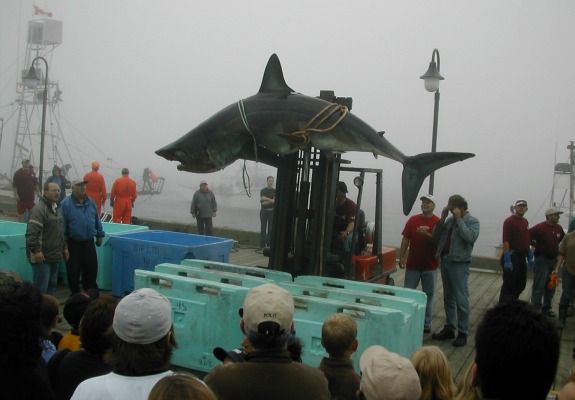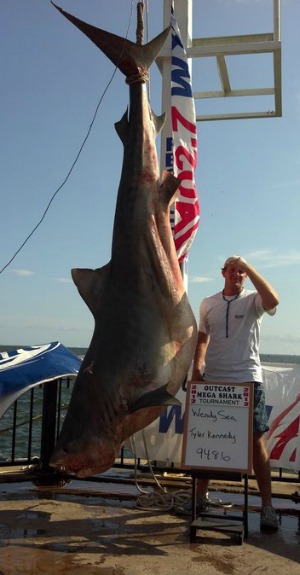Shark Week Proves We Are Fascinated by Sharks, So Why Do We Kill So Many of Them?
Around the world, these animals command a strange sort of fascination in their human admirers—an urge to see, learn and encounter, but also to kill
Shark attack in reverse: Fisherman Tyler Kennedy poses by the dead half-ton tiger shark he caught during a fishing derby this summer in Florida. Photo courtesy of Tyler Kennedy.
A real-life drama, tragically similar to the story line of the 1974 film Jaws and replete with sharks, a reluctant town mayor and hired fishermen, has erupted on a small island in the Indian Ocean.
Here, on the usually idyllic community of the French-owned Reunion Island, a 22-year-old surfer named Alexandre Rassica died after a shark bit his leg off in late July. Thierry Robert, mayor of the small Reunion beach town of St. Leu, answered by proposing that local fishermen cull the island’s shark population in spite of protections imposed in 2007, when area coral reefs were made part of a marine reserve. An immediate global outcry from shark advocates sent the mayor backpedaling, however, and he withdrew his proposal. The sharks remained protected, and begrudged surfers kept surfing.
Then, days later, another man was attacked—a 40-year-old who survived but lost a hand and a foot. About 300 outraged surfers gathered outside the St. Leu town hall, demanding an organized hunt. Two fatal shark attacks in 2011 along the island’s beaches already had the local wave-riders on edge, and this time Robert said he would open up the marine protected area to shark fishing.
Now, as Discovery Channel’s annual TV series “Shark Week” takes to the tube amid all the usual viewer excitement over the world’s most feared and fascinating predators, the hunt is officially on at Reunion Island. Hired fishermen, reportedly to be paid by the French government, have been charged with the task of removing 20 sharks from the island’s waters—10 bull sharks and 10 tiger sharks, each species being a known culprit in numerous attacks. Yes: it’s a bounty, that wayward feature of 19th-century wildlife management that many of us supposed had been done away with decades ago. And while the island’s people are understandably upset by the string of attacks, it’s fair to ask: Is imposing a shark bounty the appropriate course of action?
After my last shark post, in which I wrote about the Western Australian government’s proposal to lift protections on great white sharks after a fifth swimmer was attacked and killed in less than a year, numerous comments came in, with most readers lambasting the suggestion of intentionally reducing shark numbers in Western Australia. Several people, though, voiced support for thinning the population of great whites, and one reader even alleged that pro-shark advocates might sing in a different key if they ever spent time in the water. That was an erroneous blast of hot air, for many or most shark advocates do go into the water. They include surfers, kayakers and divers—and I’m among them. I spend many days each year snorkeling in great white shark habitat off the beaches of the San Francisco Bay Area. I’m aware of the small risk of a shark attack and even wear a Shark Shield in the hope of reducing the danger—but I wouldn’t wish to see white shark fishing, illegal since 1994, resume even though it might lower the risk of an attack.
When we walk into a coconut grove, we risk getting bonked fatally on the head. When we cross the street, we risk getting squashed by a car. And when we go surfing, swimming or diving in the ocean, we run the risk of encountering a shark. And so it seems fair that as long as we plant coconut trees and manufacture vehicles, we must refrain from organized shark hunts.
But as we speak, organized, get-paid-to-kill shark hunting is already underway—and even generating praise from the press. A young sport fisherman in Pensacola, Florida, recently won the annual Outcast Mega Shark Tournament on August 4 by reeling in a half-ton tiger shark, which one of the angler’s companions shot in the head with a pistol after a three-hour battle on rod and reel. Tiger sharks are protected in Florida state waters, but the angler, 21-year-old Tyler Kennedy, and the boat’s crew were in federal waters when they hooked the fish. After securing the big dead fish to the boat, they towed it back to port, where the official scale of the fishing derby rang in the tiger shark at 948.6 pounds. The group posed for numerous photos with the bloody, tail-tied shark, its belly distended with what would turn out later to be a seven-foot-long porpoise.
Vividly illustrating the bizarre cultural contradiction between advocating to protect sharks while simultaneously practicing the sport of killing them, Kennedy, who would catch a 336-pound bull shark the next day, told the media he was pleased that the shark’s bulging belly was not laden with unborn pups.
“We were worried that it was going to be pregnant because we really don’t want to kill a bunch of baby sharks,” he told the press.

Though icons of admiration, sharks are also targets of aggression and thrill-seeking hunters. This 1,082-pound mako was killed during the 2004 Yarmouth Shark Scramble in Nova Scotia. Such trophy fishing remains legal, and popular, today. Photo by Carla Allen.
The young Kennedy’s words were heartening, but confusing. Because which is it? Do we want sharks dead? Or alive? Around the world, these animals command a strange sort of fascination in their human admirers—an urge to see, learn and encounter, but also to kill. While “Shark Week” plays on the Discovery Channel, we’re killing the animals. Shark butchery continues in spite of laws that prohibit cutting off the the fins of live sharks—and some authorities have even shown reluctance to support shark protection laws. Estimates vary, but it seems humans kill between 26 million and 73 million sharks per year for their fins, a prized and essential component in the controversial Asian delicacy shark fin soup. Other mortality totals are not even accounted for. Even some research institutes that advocate shark conservation seem reluctant to criticize shark derbies, which provide them with specimens for dissection. To be fair, shark derbies kill a small percentage of total sharks killed each year—but the public celebration and cheer that derby fishermen receive are troubling. The Outcast Mega Shark Tournament is hardly the only active derby. The Monster Shark Derby is held every summer in Martha’s Vineyard, where crowds of summering tourists cheer and applaud anglers as they haul their dead mako, thresher, porbeagle and tiger sharks from their boats for weigh-in. The Yarmouth Shark Scramble in Nova Scotia, Canada, is still one more, a derby spotlighted in journalist Carla Allen’s new book, Shark On Line. The Food Network’s “The Wild Chef” even sent their hosts out fishing several years ago on a boat at the Yarmouth derby to kill a shark, for the paltry thrill of cooking it at sea. That these derbies and others still take place is a discouraging thorn in the side of conservationists, and a reminder that the lust that has driven humans to wage war on so many cohabitants of the planet still boils in our blood. Opposition to shark derbies is loud (this Facebook page is dedicated wholly to stopping shark-killing tournaments). Yet enough media sources cover the events that it seems clear they’re pandering to some segment of their readership enthralled at seeing sharks die.

The author inspects the head of a mako shark, caught, killed and butchered for its fins and meat in the Sea of Cortez. Roughly 100 million sharks are killed by people every year, largely to support an unsustainable culinary tradition. Photo by Milton Wong.
In related news, the aforementioned Shark Shield—an electronic device that costs a pretty penny (about $600)—may not be the shark deterrent we would like it to be. Tests by researchers in South Australia found no difference in the frequency with which great whites attacked tuna carcasses fitted with the device and those served au naturel. But a similar series of tests conducted in South Africa produced conclusions well in favor of the Shark Shield’s purported effectiveness.
In less related news, juvenile salmon sharks, possibly affected by a bacteria, have been washing ashore on Northern California beaches. The salmon shark is a close relative of the great white and the mako. They can grow to hundreds of pounds in weight and bear a formidable armory of teeth but are not known to attack humans. When the first beaching incident of this summer occurred on August 5 at Manresa State Beach, several beachcombers found the stranded juvenile and carried it back to the water. Later the same day, another juvenile appeared thrashing on a beach in Pacifica—and do you know who came to the rescue and delivered the pup back to water? Surfers.

A juvenile salmon shark, relative to the great white, lies stranded on a beach in Northern California in August. Photo courtesy of the Pelagic Shark Research Foundation.
Planning Your Next Trip?
Explore great travel deals
Smithsonian magazine participates in affiliate link advertising programs. If you purchase an item through these links, we receive a commission.
/https://tf-cmsv2-smithsonianmag-media.s3.amazonaws.com/accounts/headshot/Off-Road-alastair-bland-240.jpg)

/https://tf-cmsv2-smithsonianmag-media.s3.amazonaws.com/accounts/headshot/Off-Road-alastair-bland-240.jpg)